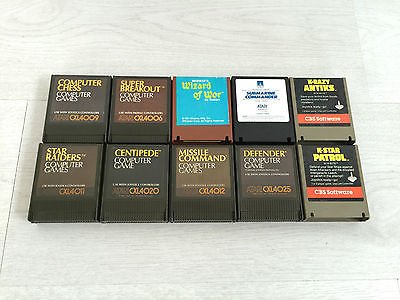
Some Atari 8-bit cartridges. The brown ones are Atari releases.
In the early days of the Atari 8-bit machines, pre-5200 era, Atari came out with a bunch of arcade game cartridges; as mentioned in the introduction Atari owned the rights to a lot of popular coinops back there so it was only natural that they would produce ports for their own line of 8-bit machines. Some of these were excellent, and some of them rather missed the mark for various reasons.
Atari Getting It Right
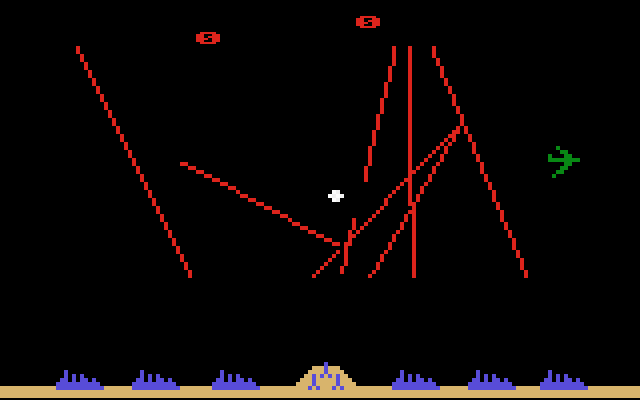
Missile Command. Excellent.
There had already been a very good (nay miraculous, considering the technical limitations of the VCS and just how not at all cut out for drawing multiple arbitrary lines that system was) port of Missile Command onto the VCS game console, but Rob Zdybel’s port to the A8 was sublime. It managed to incorporate just about every feature of the coinop, including features such as MIRVs, satellites and planes, and those complete and utterly bastardy little guided bomb thingies that were such a bugger to shoot. The three missile bases of the coinop were consolidated into one, but that was a necessary compromise in order to fit the game to controllers of the day which had but one button, and although it simplified the gameplay somewhat it certainly didn’t detract too much from what was a great port, and well worth spending a bit of time with to this day. I believe that later releases of this cart for the XL/XE machines even allowed the user to plug in an Atari ST mouse and use it to control the cursor after selecting trakball mode (Ctrl-T).
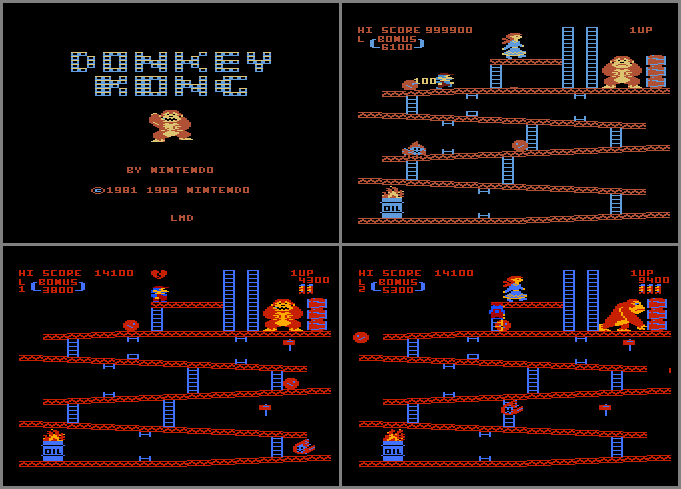
Donkey Kong. I never found the donkey.
Atari’s Donkey Kong port isn’t perfect – if you wanted to get really picky you might moan about the slightly too thin girders and that on the first screen there was one less level than in the coinop so Kong is on the wrong side (completely understandable as the coinop had a vertical aspect ratio), and masking might’ve been nicer than XORing. But in terms of playability this is a very good port indeed. Most home versions of the day managed to lose at least one of the levels from the arcade game due to constraints of space but this port retains all 4 of the coinop’s levels plus the animated intro and intermission screens. Surprisingly it was written by a guy who didn’t even like Donkey Kong that much – read his blog entry about it here, for a good insight into what it was like to actually be in the belly of the beast at Atari working on these arcade ports. Visually the Coleco port was probably a bit more attractive but you could at least play the A8 port with a controller that wasn’t almost entirely unpleasant, making it my Kong winner of that era for pure gameplay.
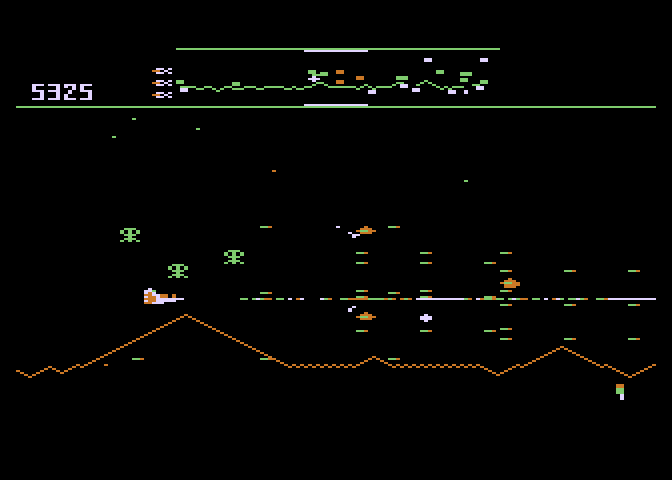
Defender
Here’s a good example of an arcade port that’s toned down somewhat for its home incarnation. Arcade Defender is one of the most notoriously difficult arcade games of the era (in modern times no doubt people would start comparing it to Dark bloody Souls) and this port is a lot more forgiving. Part of Defender’s difficulty lies in its control method, which is here tamed to a much more conventional joystick control, with the keyboard’s space bar activating the Smart Bomb. This led to the demise of the space bar on my own Atari 800 – I was playing Defender with the 800 sat on the ground where I was using my foot to trigger Smart Bombs. I must have been too vigorous one day and broke the space bar, forcing me to up my game and play without using Smart Bombs. I did get to the point where I was able to play forever even on hard difficulty and no Smart Bombs, which further indicates the lenience of the port, since I have never come anywhere near that on an actual coin-op.
The port itself is smooth and competent and features all the essential elements of Defender gameplay. The ship’s a bit on the large side and the sound effects don’t have quite the same bite as the Williams originals, but it’s one of the nicer looking and sounding ports of the time. Explosions are appropriately shattery, although they seem to be made up of generic particles rather than the actual parts of the disintegrating sprite’s bitmap as in the coinop. It feels a little bit soft and mushy in control compared to the original but that just makes it feel comfortable and easy to settle into; it’s not hyper twitchy. It makes Defender nicely accessible to most people, who might not have the skills or patience to get to grips with a more accurate port.
If you do want to experience Defender gameplay that’s closer to the original in terms of difficulty then I recommend you check out Planetoid on the BBC Micro, or Guardian on the C64, both of which use the keyboard rather than the joystick to more accurately emulate the coinop’s multitude of buttons, and both of which are hard as a bastard.
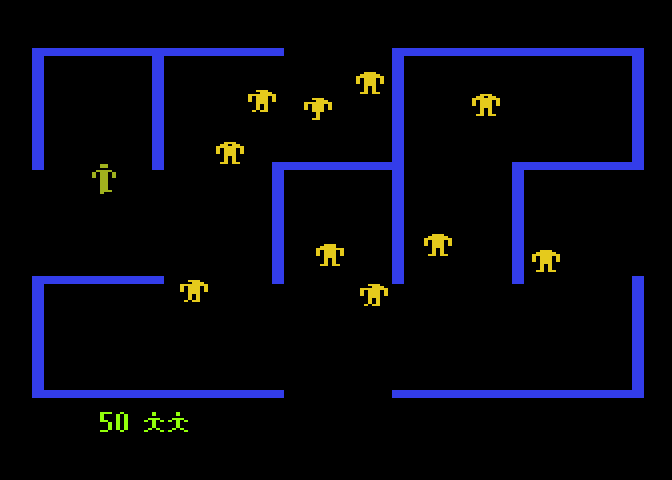
The Humanoid must not escape
Atari’s port of Berzerk to the 2600 was pretty decent for that system but if you studied the gameplay you noticed that the robots never strayed outside of the horizontal band of screen space in which they originated, a constraint imposed by the limitations of the VCS’ hardware that rendered accurate reproduction of the coinop’s gameplay impossible. This A8 port, however, suffers from no such constraints and is as perfect a rendition of coin-op Berzerk as you are likely to see on any machine of that era. There is even the taunting speech from the robots, calling out “The Humanoid must not escape” and “Chicken, fight like a robot” should you leave the room before all of them are dead. The only difference is that the speech is only generated between levels since without speech generation hardware the 6502 has to play back the samples by hand, which can’t be done at the same time as running the game. That doesn’t detract at all from an excellent port of Berzerk though.
Atari Getting It Not So Right
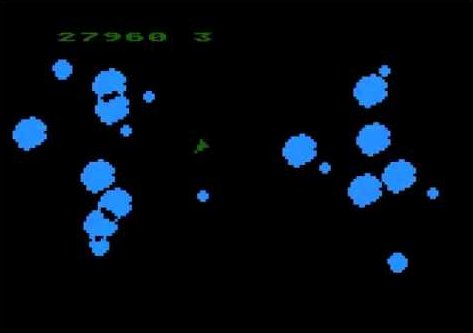
Asteroids. In my eyes. Ow.
I have to begin by pointing out that if you look at the truly dreadful things perpetrated in the name of Asteroids by other people on other systems then it must seem positively churlish to call this out as not being good, since on most of those other systems it’d be considered great. However it’s the A8 here and we expect a degree of arcade-style lustre which is simply entirely absent – look at it, the poor thing’s ugly as sin. Plus it’s Atari making a port of one of their own best known and loved coinops so I’d expect the highest standards to apply.
To add insult to injury Atari had already produced an excellent port of Asteroids to the 2600 which was actually verging on the miraculous, and which despite a bit of sprite flicker and some constraint of the asteroids’ trajectories nonetheless managed to deliver a decent looking and playing game on that system. Here the game ported to a much more capable system actually ended up looking worse. Multiplexed sprite graphics were replaced by XOR plotted monochrome playfield graphics, which allowed more asteroids to be on screen at once, but which also unfortunately ended up being flickery and ugly and looking like a dog’s breakfast when a lot of asteroids occupied the same space.
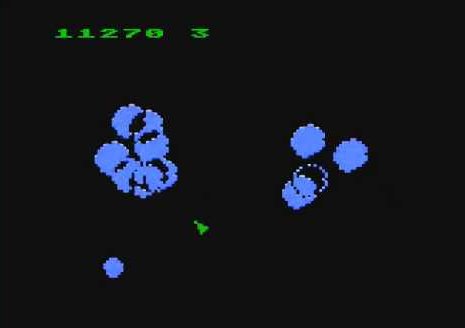
An XOR dog’s breakfast.
Even the motion of the asteroids got a bit choppy when there were a lot on screen. This game was intended to be one of the flagship titles on the 5200 (game system never released in proper British parts, consisting basically of an a8 in a gigantic, enormous case paired with unreliable, unsuitable analogue joystick controllers for no apparent reason, so we were actually rather better off without it, especially as most of its games were either derived from existing a8 games or could be trivially backported to the a8). It was never actually released on the 5200 though, perhaps because someone sensible at Atari decided that a dog’s breakfast looking port of Asteroids on a system with a wholly unsuitable controller might not be showing the company or the system in their best light.
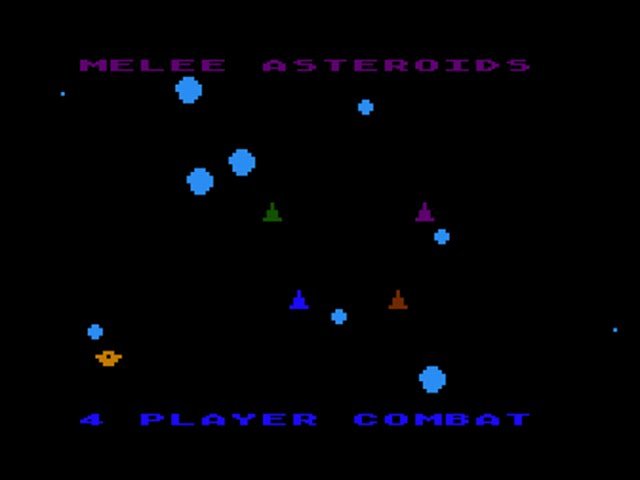
Fun multiplayer options though
It is a shame though because not everything about the game is poor. Moving the asteroid rendering to the playfield freed up the sprite system allowing for a variety of multiplayer local gameplay options for up to four players at once, whcih was actually kind of fun. And as I said at the start, on any other system this would probably be considered good. It’s just that we hold the A8 and Atari to much higher standards and this just doesn’t make the grade.
If you want to see just how well an a8 machine can do Asteroids, then you should check out this version, made in 2012:
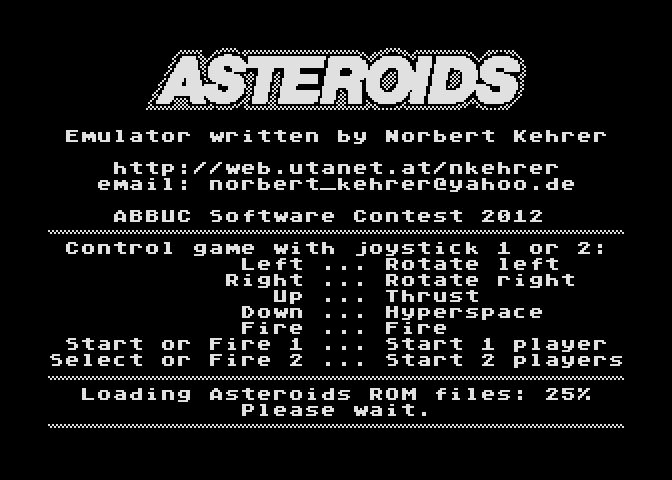
Your eyes do not deceive you.
Yep, that’s not a port; that’s an emulator. It actually loads and runs the code from the ROMs of the real arcade version of Asteroids. Additional software emulates the vector drawing and sound routines and it runs fast enough to be fully playable.
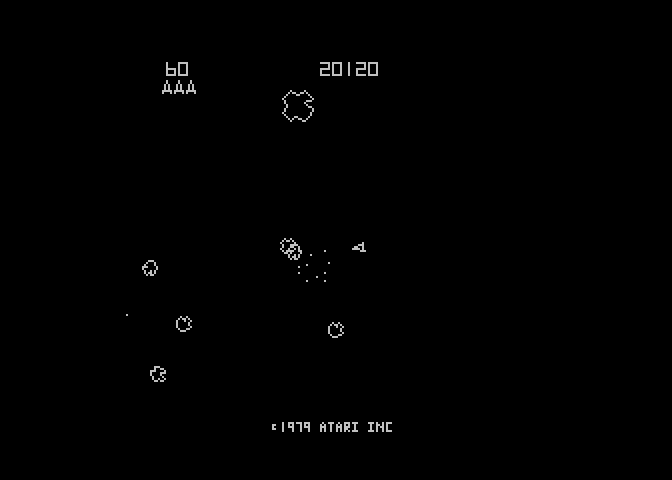
A miracle.
This is a truly remarkable achievement on behalf of the programmer, and the only example I have seen of an emulator running on a system that was designed a couple of years earlier than the thing it’s emulating.
Now for another truly remarkable achievement, although in an entirely different sense…
Cast your mind back. It is the early 80s (and there will not be time for Klax for nearly another decade). You are Atari. You own the license to one of the hottest arcade games of all time, Space Invaders. You’ve already done a decent VCS version that flew off the shelves. You have expert programmers on hand to do ports onto hardware that you designed. Space Invaders isn’t even that difficult of a game to program. So your own A8 port of Invaders is going to be a bit special, yes?
Erm…
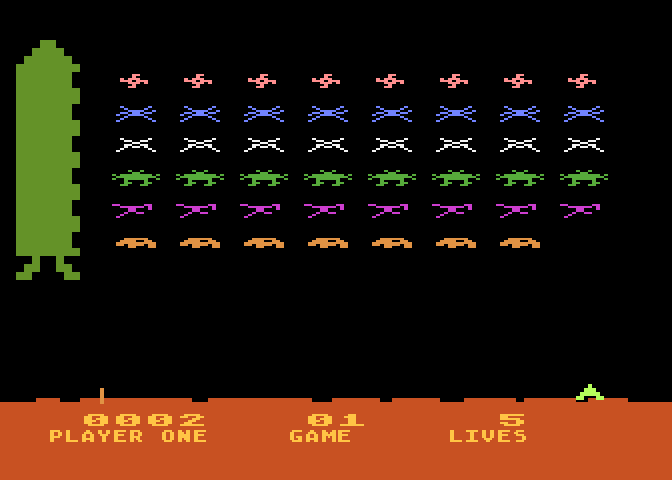
What the actual fuck.
If you are at all familiar with what Space Invaders looks like I am sure that there are several questions that will go through your head on looking at that image. Questions like “where the fuck are my houses”? Questions like “what the fuck is that giant shed at the side of the screen in aid of?” and “where are the iconic Invader shapes that everybody in the Universe recognises instantly and the license for which you paid a crapload of cash to Taito?”
That kind of thing. Lordy knows what they were thinking, for this is a rubbish port of a great game.
I think the shed at the side is supposed to be some kind of rocket. At the start of every wave the invaders actually come marching out of it, giving you plenty of time to pick plenty of them off before they’ve even mustered their ranks in the play area. Maybe that’s why the houses were taken away as you had an unfair advantage in murdering the Invaders as they came out the shed doors. I really don’t know. It gives me a headache to think about someone at Atari looking at this port and going “yup, looks like a good version of Space Invaders to me”, and signing off on it, maybe even paying the programmer a bonus for producing what is so blatantly obviously a huge pile of smeg to anyone with competent eyes to see. Maybe they’d given S. Munnery a job, I don’t know. This is why arcade ports and remakes should never be trusted to anybody whose main motivation is money alone. They must be done by people who love and will respect the original work or you end up with this kind of crap.
I decided to take a look at the 5200 version of Space Invaders to see if they’d improved it at all:
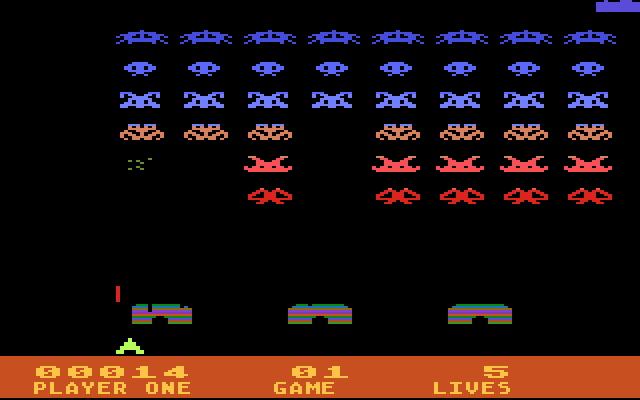
Still smeg.
At first glance you’d be forgiven for thinking that they’d improved it because there are at least houses this time, even if they are tiny, rubbish ones. Which inexplicably have random colour streaks through them, and not in a cool-looking raster bar kind of way, just in a random rubbish way. The Invader shapes would be fine shapes for a canine’s breakfast I suppose, and notice how they are all coloured in various shades of fugly. Nice. But at least the shed’s gone… or has it? In fact when you play it’s evident that although the awful shed graphic has been removed the game behaves in every way as if it’s still there. The Invaders still march out inauthentically from the left. Worst of all once out they don’t even traverse the entire screen properly as they ought; instead they turn around where the invisible shed ought to be, which is confusing and rubbish when you’re playing. It’s obviously they’ve just reused the old a8 code, bolting on some rubbish houses, turning off the shed graphics and changing the invader graphics but not even changing the associated logic to reflect the removal of the shed. I really don’t understand the attitude that must have prevailed at Atari at that time. Why not give the job to somebody who actually gave a fuck about it, especially given that it’s supposed to be, you know, a flagship title on your brand new console. You’d think it’d be worth making the effort, even if it did cost you a few more bucks, or the effort of finding some loyal fan who’d do the job more for love than money, but no, just tweak up an already shite port and call it done. It beggars belief, it really does. I just can’t begin to get my head round it. I’ll never understand “business”.
If you want to play a half decent Space Invaders on the a8 then I would recommend seeking out Roklan’s Deluxe Invaders:
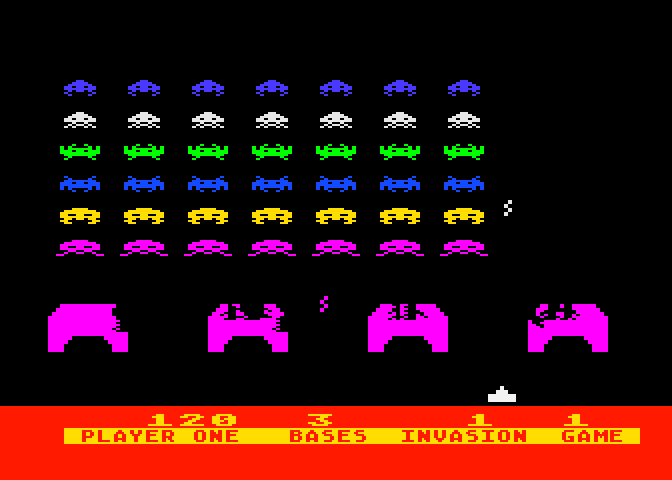
Recognisably Space Invaders.
It isn’t perfect but it is at least recognisably Space Invaders (in fact I am not sure how they got away with doing such a close clone, unless they had their own licensing deal with Taito back in the day). You have houses, the Invaders look like Invaders, there’s no shed, and there’s also a pleasing number of game variations to enjoy.
It isn’t the most authentic Invaders from that era though. For that you need to head over to the Vic-20 and look at the excellent Vic Avenger cartridge, which is as close a clone of Space Invaders as I have ever seen, reproducing almost perfectly nearly every quirk of the original game, despite running in a much smaller screen area.
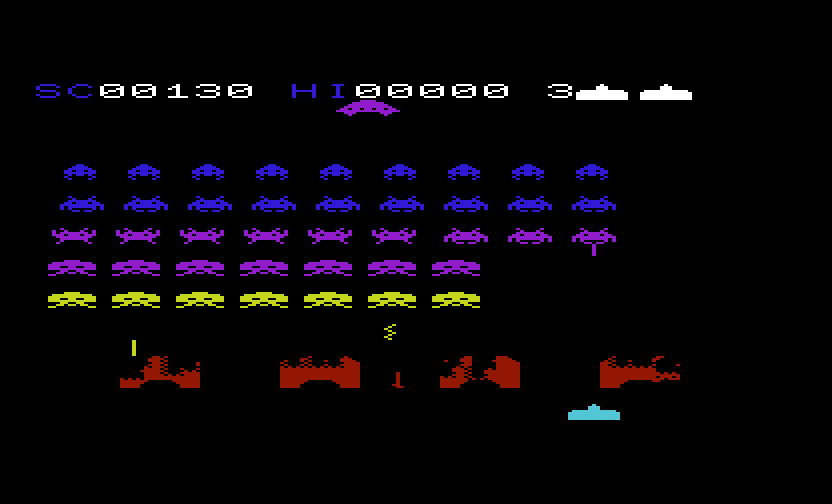
VIC Invaders. Best Invaders.
The Invaders of the Vic version look a little portly due to the Vic’s odd screen proportions, but apart from that the graphics are pretty much spot on to the coinop. But it’s other little bits of attention to detail in reproducing the game that make the Vic version stand out. For one, if you look at the Roklan game, you will see that everything moves very smoothly – including the block of Invaders itself, they all move smoothly as a body, wiggling as they go; something that it’s naturally very simple to do on the Atari, animating characters on the playfield and just scrolling them about.
Only if you go and watch a real game of Space Invaders you’ll see that that’s not how it works. In real Space Invaders hardware limitations meant that the machine could only move one Invader at a time, and early on in the level you can see that the motion kind of ripples through the block of Invaders as they shuffle left and right on the screen. As the player shoots away Invaders, the hardware has fewer to draw, and so the overall motion of the pack of Invaders starts to speed up. This effect of the game’s hardware limitation, and its effect on gameplay, was recognised as a positive thing by the game’s designer and became a defining characteristic of the game. There is a feeling when you play of organically chipping away at the game’s very code and hardware capability as you battle towards the end of a level; it doesn’t just go “oh there’s thirty Invaders left now; I’ll speed up the attack pattern a bit”, it’s something that you make happen by altering the task that the code has to do through your ablative actions. In both the Atari and Roklan games you never see that, because they use the a8′s playfield and character handling to make the burden of moving the block of Invaders almost nonexistent – a clever move technically that uses the target hardware well, but one which unwittingly removes part of the soul of the game they’re trying to replicate.
The Vic game gets it pretty damn near perfect. Well worth firing up an emulator for if you’re inclined to study this further.
Anyway! That’s enough arcade ports for now. There are tons more that I’ll get to in future weekends, although next up I think I’ll do some original A8 games rather than just ports. There was a lot of great stuff on there. I hope some of you are playing along and maybe coming to discover a new love for Atari and their 8-bits that you might not have known before ![]() .
.











